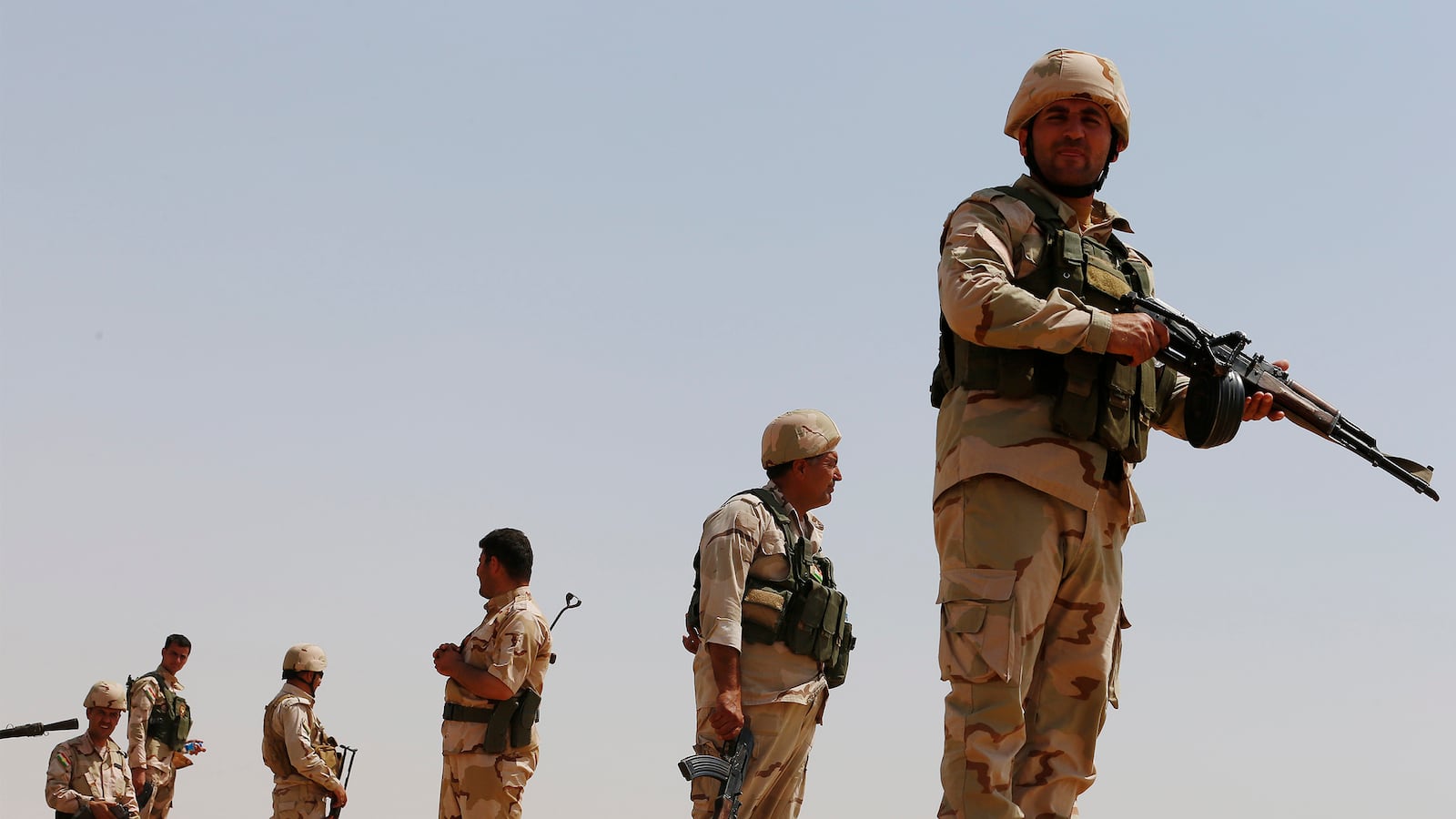ISTANBUL — The terror of poison gas has begun to spread on the front lines where Kurds are fighting the so-called Islamic State. During a battle on Wednesday, some 60 Iraqi Kurdish soldiers, known as peshmerga, suffered some of the horrible symptoms associated with mustard gas, the infamous chemical agent first used in combat in World War I. News of the incident first came from the German defense ministry, which has been training some of the Kurdish units. U.S. officials are taking reports very seriously and say they are still investigating.
Where the Islamic State, widely known as ISIS or ISIL, might have gotten chemical weapons is an open question. Although the Syrian regime cooperated with the destruction of most of its chemical arsenal after the threat of U.S. airstrikes two years ago, United Nations inspectors have been concerned that some mustard gas was not actually burned away as claimed. ISIS has overrun some major Syrian military bases, and may have found remnants of the old stockpiles. It’s also conceivable that former members of Saddam Hussein’s army, now serving with ISIS, knew where the Iraqi tyrant hid some of his arsenal.
Whatever the source, the use of gas against Kurdish fighters is fraught with symbolism. In 1988 Saddam used a more potent form of poison gas to kill thousands of men, women and children in the town of Halabja as part of a genocidal campaign against the rebellious Kurdish population. Three years later, even after Saddam’s military was defeated in Desert Storm, fear that he would use chemical weapons against the Kurds again led thousands to flee to freezing hillsides near the Turkish border.
How they will react to this new threat from ISIS and its ex-Saddamist collaborators is unclear. But it will no doubt be a complicating factor in the already fractured alliance of forces that the Obama administration has tried to cobble together for the ground war against the self-declared caliphate and its legions of butchers in both Iraq and Syria.
In a separate development, Turkish authorities say they have reached an understanding with Washington that the Kurdish defense forces the U.S. has been coordinating with in the fight against the Islamic State group in Syria can’t cross west of the Euphrates or assist to protect a proposed buffer zone in the north of the country. If so, the agreement highlights the limits of the U.S.-led coalition’s alliance with the Syrian Kurds.
Without a boots-on-the-ground force that the Americans feel they can work with beyond the Kurdish areas, the proposed zone stretching 90 kilometers along the Turkish border and 40 kilometers into Syria risks becoming completely unviable. Airpower won’t be sufficient to drive Islamic extremists from the parts of the region that they already occupy, nor will airstrikes be enough to keep them at bay once they have been forced out.
As far as Turkish officials are concerned, the Obama administration is going to have to distance itself from the Syrian Kurdish factions affiliated with the PKK rebels of Turkey and agree to work with Islamist militias that Washington has shunned in the past. U.S. officials say they see Ankara trying to maneuver Washington into a position where it has no alternative.
The U.S. has been talking to some of the more moderate militias about setting up an operations room for the zone, but officials have not been in direct talks with the likes of Ahrar al-Sham, a major Islamist militia that announced this week it is prepared to help defend it.
The proposed zone between Marea and Jarablus is not exactly a safe haven for those who might return, but at a minimum it is supposed to be ISIS-free. At present a chunk of it is held by the Islamic State group and this week, evidently mocking the U.S.-Turkish plan, ISIS launched an offensive on the parts they don’t control, including on a group of towns and villages at the heart of the area, further complicating the problem of how to secure the zone from ground attacks and infiltration by ISIS fighters.
“The value-added of Washington’s principal ally in northern Syria—Kurdish forces—is diminishing,” according to Noah Bonsey, a senior analyst at the Brussels-based International Crisis Group. The Kurdish People’s Protection Units (YPG), the armed wing of the Democratic Union Party (PYD), the Syrian offshoot of the outlawed Turkish Kurdistan Workers’ Party (PKK), have been highly effective in wresting territory back from ISIS but beyond Kurdish-majority areas their support is “more liability than asset,” Bonsey argues.
Last month President Barack Obama told reporters at the Pentagon his strategy for defeating the Islamic State group will take time to work and that there is no substitute for working through indigenous forces. But the refusal of “indigenous forces” to work together is undermining this approach.
Walk into a room full of Syrian rebel commanders and say the word “Kurd” and you get the same reaction as you would if you said instead “Assad.” Ask them if they can work with the YPG and the answers that come back range from a flat “no” to a spiel of complaints and imprecations, as I have found in several recent discussions about future war strategy with commanders in the dusty Turkish border towns of Gaziantep and Kilis as they seek to recruit volunteers and secure supplies for their brigades.
Among Syrian refugees the prospect of some kind of buffer zone being established in northern Syria is welcomed. “Better to be inside Syria than here,” says Mohsin, a 22-year-old from Deir Ez-Zour. “There’s no work here, the Turks don’t want us here and I’d prefer to be back in Syria, if I am not going to get bombed by Assad.” For the past year, since he arrived in Kilis, a Turkish border town that has doubled in size because of a refugee influx, Mohsin has moved from the official refugee camp to squatting in rundown apartments rented by other refugees in neighboring Gaziantep and then back again to Kilis.
Rebel commanders, too, see the proposed zone as a glimmer of hope—an area where they can escape relentless airstrikes from the Syrian regime. But this has to be a Kurd-free zone as well, they say, even if Kurdish support would improve security.
The rebels have long harbored resentment toward the PYD, going back to the early stages of the civil war when the party refused to join in the broader fight against President Bashar al-Assad, focusing on just the Kurdish heartland in the northeast. Assad withdrew many of his forces from Kurdish areas in the early months of the civil war, and an uneasy co-existence was maintained between the remaining government troops and the Kurds, allowing the PYD to organize a parallel system of government.
Like the Turks, Syrian rebel commanders say they suspect the Kurds want to establish a breakaway state along the Turkish border stretching from the Iraq border to the east to the Mediterranean coast on the West. Kurdish leaders deny the claim.
Fighters from a couple of FSA-linked militias fought alongside the YPG this year in the defense of Kobani during the long ISIS siege of that Kurdish town. And they were part of the Kurdish-led force that captured earlier in the summer the mainly Arab border town of Tal Abayad. But their numbers are small and while the cooperation looked good to the outside world it was more cosmetic than serious.
“They are just small militias and have no respect,” sneers a rebel commander. “They have shifted alliances frequently—they are opportunists and not trusted; none of us want them,” says rebel commander Abdul Rahman, who works with both moderate and Islamist brigades.
Mutual suspicion between the mainly Sunni Arab rebel militias and Kurds is, if anything, deepening, and it flared when the YPG went beyond its home territory in June and reached into traditional Arab villages last month to oust ISIS militants. “We now have as great a fear of the Kurds as Daesh,” says rebel commander Abu Mohammed, using the derogatory Arab acronym for ISIS.
So, if an ISIS-free zone is to be established and effectively defended it most likely will have to be done by Arab rebel forces with local credibility and backing. And trying to shape a buffer-zone defense force has become even more of a challenge since the airstrike by U.S. warplanes Tuesday on an arms depot of an independent militia, Jaysh al-Sunna. A small brigade first raised in Homs that has links with the Western and Gulf-backed Free Syrian Army but also joined the Islamist-dominated Army of Conquest (Jaysh al-Fatah) in March.
The airstrike has enraged Islamist brigades who only this week announced they are willing to help to protect the buffer zone north of Aleppo. They are interpreting the raid as a warning from the U.S. to discontinue attacks on the Kurdish border town of Afrin to the north of Idlib, which saw last week al Nusra fighters and Islamist allies storm a district of the town in preparation, the Kurdish defenders fear, for a wave of suicide bombings.
Afrin is a Kurdish enclave cut off from the swathe of YPG land to the east of the Euphrates. Attacks on the enclave by Arab rebel forces risks inviting a YPG backlash. Turkish officials say Washington has fully accepted that the YPG must not cross west of the Euphrates. And that stricture has been fully communicated to the Kurds. “They have been told they must not enter territory between Jarablus and Azaz,” an official told The Daily Beast. That demand, if heeded, would preclude the YPG relieving the canton of Afrin from assault.
So, who can Washington and Ankara turn to in order to defend the buffer zone on the ground, if they are not going to put their own boots there?
Western diplomats here believe an announcement by al Qaeda affiliate Jabhat al-Nusra this week of withdrawal from the area of the proposed zone was engineered by Ankara, making it slightly more palatable for Washington to work with the al Qaeda offshoot’s Islamist allies. But in the recent past senior U.S. officials have told The Daily Beast that it would be impossible for Washington to work with Ahrar al-Sham. “Maybe they are not black but they are deeply dark,” a senior State Department official told me earlier in the summer.
When asked if that view is now shifting, officials are noticeably silent.






